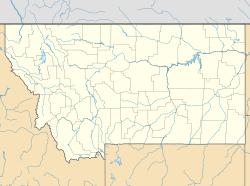Lake McDonald, Montana facts for kids
Quick facts for kids
Lake McDonald, Montana
|
|
|---|---|
| Country | United States |
| State | Montana |
| County | Flathead |
| Elevation | 3,225 ft (983 m) |
| Time zone | UTC-7 (Mountain (MST)) |
| • Summer (DST) | UTC-6 (MDT) |
| ZIP code |
59921
|
| Area code(s) | 406 |
| GNIS feature ID | 785919 |
Lake McDonald is a small community in Flathead County, Montana, United States. It is not an official town with its own government. Instead, it is called an unincorporated community. This means it is a group of homes and buildings that are not part of a city or town.
This community is special because it sits right on the northeastern shore of Lake McDonald. This beautiful lake is located inside Glacier National Park.
Contents
Discovering Lake McDonald's Name
The name of the lake, and therefore the community, has a history. Before the year 1878, the lake was known by a different name: Terry Lake. It was named after a general named Alfred Terry.
Later, the National Park Service officially decided on the name Lake McDonald. The National Park Service is the group that manages and protects all the national parks in the United States. They made sure the name was set for good.
Exploring the Area Around Lake McDonald
The community of Lake McDonald is a gateway to the amazing Glacier National Park. This park is famous for its stunning mountains, clear lakes, and ancient glaciers.
Visitors often come to the Lake McDonald area to enjoy nature. They can go hiking, boating, or simply enjoy the beautiful views. The park is home to many different kinds of plants and animals.
Wildlife in Glacier National Park
The area around Lake McDonald is full of interesting wildlife. You might see large animals like grizzly bears and moose. Smaller creatures like marmots and various birds also live here.
It is important for visitors to respect the wildlife. Keeping a safe distance helps protect both people and animals.
Plants and Trees of the Region
The forests around Lake McDonald are filled with tall trees. You can find Douglas firs, ponderosa pines, and western redcedars. In the spring and summer, many colorful wildflowers bloom. These plants add to the beauty of the park.



